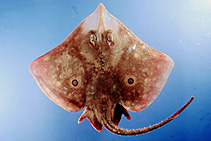Rostroraja texana (Chandler, 1921)
Roundel skate
Uploaden van uw Foto's en video's
Pictures | Stamps, coins, misc. | Google afbeeldingRostroraja texana
Picture by NOAA\NMFS\Mississippi Laboratory
Pictures | Stamps, coins, misc. | Google afbeeldingRostroraja texana
Picture by NOAA\NMFS\Mississippi Laboratory
Classificatie / Names Lokale namen | Synoniemen | Catalog of Fishes(Genus, Soort(en)) | ITIS | CoL | WoRMS | Cloffa
Elasmobranchii (haaien en roggen) (sharks and rays) > Rajiformes (Skates and rays) > Rajidae (Skates)
Etymology: Rostroraja: Latin, rostrum = beak + Latin, raja, -ae = a sting ray (Ref. 45335).
Etymology: Rostroraja: Latin, rostrum = beak + Latin, raja, -ae = a sting ray (Ref. 45335).
Environment: milieu / climate zone / depth range / distribution range Ecologie
marien demersaal; diepte 1 - 183 m (Ref. 117734), usually 15 - 110 m (Ref. 37039). Subtropical; 14°C - 28°C (Ref. 26938); 30°N - 18°N, 98°W - 80°W
Verspreiding Landen | FAO regio's | Ecosystemen | Voorkomen | Point map | Introducties | Faunafri
Western Central Atlantic: Florida, USA and the Gulf of Mexico.
Lengte bij maturiteit / Grootte / Gewicht / Leeftijd
Maturity: Lm 53.7, range 48 - 56 cm
Max length : 53.0 cm WD mannelijk / geslacht onbekend; (Ref. 7251); max. gerapporteerde leeftijd: 9 Jaren (Ref. 117734)
Max length : 53.0 cm WD mannelijk / geslacht onbekend; (Ref. 7251); max. gerapporteerde leeftijd: 9 Jaren (Ref. 117734)
Korte beschrijving Determinatiesleutels | Morfologie | Morfometrie
Disk diamond-shaped; round dark spot surrounded by pale ring on base of each pectoral fin. (Ref. 26938). No small pale or dark spots on upper surface of disk, but sometimes dark blotches. No scapular spines, 1 middorsal row of spines. Distance from ocellus to eye usually less than or about equal to distance between ocelli. Snout with a clear area on each side (Ref. 7251). Upper surface rich chocolate or coffee brown, translucent on either side fo rostral cartilage. Lower surface plain white (Ref. 6902).
Occur from near shore to 183 m depth at temperatures ranging from 14 to 28° C but it is most common inshore of 91 m at 16-25°C. Young occur in shallow bays. Adults tend to live offshore (Ref. 26938). Adults feed mainly on decapod crustaceans and to a lesser extent on other benthic invertebrates and fishes. Oviparous. Distinct pairing with embrace. Young may tend to follow large objects, such as their mother (Ref. 205). Eggs are oblong capsules with stiff pointed horns at the corners deposited in sandy or muddy flats (Ref. 205). Egg capsules are 6.3 cm long and 3.8 cm wide (Ref. 41359).
Levenscyclus en paargedrag Maturiteit | Voortplanting | Paaien | Eieren | Fecunditeit | Larven
Oviparous, paired eggs are laid. Embryos feed solely on yolk (Ref. 50449). Distinct pairing with embrace. oung may tend to follow large objects, such as their mother (Ref. 205).
Hoofdreferentie
Upload your references | Referenties | Coördinator : McEachran, John | Medewerkers
McEachran, J.D. and K.A. Dunn, 1998. Phylogenetic analysis of skates, a morphologically conservative clade of elasmobranchs (Chondrichthyes: Rajidae). Copeia 1998(2):271-290. (Ref. 27314)
Status op de Rode Lijst van het IUCN (Ref. 130435: Version 2024-2)
Niet bedreigd (LC) ; Date assessed: 21 June 2019
CITES
Not Evaluated
Gevaar voor de mens
Harmless
Gebruik door de mens
Visserij: van minder commercieel belang; aas: occasionally
FAO - Publication: search | FishSource |
Meer informatie
Population dynamics
Groeiparameters
Max. ages / sizes
Length-weight rel.
Length-length rel.
Lengtefrequenties
Massaconversie
Rekrutering
Abundantie
Groeiparameters
Max. ages / sizes
Length-weight rel.
Length-length rel.
Lengtefrequenties
Massaconversie
Rekrutering
Abundantie
Life cycle
Voortplanting
Maturiteit
Maturity/Gills rel.
Fecunditeit
Paaien
Spawning aggregations
Eieren
Ontwikkeling van de eieren
Larven
Larvale populatiedynamiek
Voortplanting
Maturiteit
Maturity/Gills rel.
Fecunditeit
Paaien
Spawning aggregations
Eieren
Ontwikkeling van de eieren
Larven
Larvale populatiedynamiek
Anatomy
Kieuwoppervlak
Brain
Otolith
Kieuwoppervlak
Brain
Otolith
Physiology
Body composition
Nutrients
Zuurstofverbruik
Zwemtype
Zwemsnelheid
Visual pigments
Fish sound
Diseases & Parasites
Toxicity (LC50s)
Body composition
Nutrients
Zuurstofverbruik
Zwemtype
Zwemsnelheid
Visual pigments
Fish sound
Diseases & Parasites
Toxicity (LC50s)
Genetics
Genetica
Heterozygosity
Erfelijkheid
Genetica
Heterozygosity
Erfelijkheid
Human related
Aquaculture systems
Aquacultuurprofielen
Kweeklijnen
Ciguatera cases
Stamps, coins, misc.
Aquaculture systems
Aquacultuurprofielen
Kweeklijnen
Ciguatera cases
Stamps, coins, misc.
Tools
E-boek | Veldgids | Determinatiesleutels | Lengtefrequentie Tool | Levenscyclus tool | Verspreidingskaart | Classification Tree
| Catch-MSY |
Speciale rapporten
Bekijk gegevens voor het houden in een aquarium | Bekijk Fact Sheets voor de soort | Bekijk Aquacultuur Fact Sheets
Download XML
Internetbronnen
AFORO (otoliths) | Aquatic Commons | BHL | Cloffa | BOLDSystems | Websites from users | Bekijk FishWatcher | CISTI | Catalog of Fishes: Genus, Soort(en) | DiscoverLife | ECOTOX | FAO - Publication: search | Faunafri | Fishipedia | Fishtrace | GenBank: genoom, nucleotide | GloBI | GoMexSI (interaction data) | Google Books | Google Scholar | Google | IGFA World Record | MitoFish | OceanAdapt | Otolith Atlas of Taiwan Fishes | PubMed | Reef Life Survey | Socotra Atlas | Tree of Life | Wikipedia: ga naar, zoek | World Records Freshwater Fishing | Zoological Record
Estimates based on models
Preferred temperature (Ref. 123201): 21.2 - 27.5, mean 24.9 °C (based on 230 cells).
Fylogenetische diversiteitsindex (Ref. 82804): PD50 = 0.5000 [Uniqueness, from 0.5 = low to 2.0 = high].
Bayesian length-weight: a=0.00302 (0.00141 - 0.00645), b=3.24 (3.07 - 3.41), in cm total length, based on LWR estimates for this (Sub)family-body shape (Ref. 93245).
Trofisch niveau (Ref. 69278): 3.8 ±0.58 se; based on food items.
Generation time: 4.8 ( na - na) years. Estimated as median ln(3)/K based on 2 growth studies.
Weerstandsvermogen (Ref. 120179): laag, minimale populatieverdubbelingstijd 4,5-14 jaar (k = 0.29; tmax = 9; tm = 5; Fec assumed to be <100).
Fishing Vulnerability (Ref. 59153): Moderate to high vulnerability (45 of 100).




